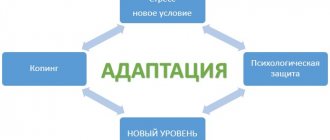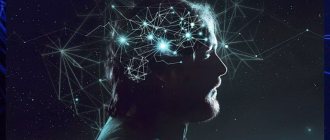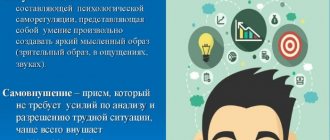Thinking is the highest stage of human cognition. It is based on constant changes in ideas and concepts. It makes it possible to obtain knowledge that is not direct information obtained using the first signaling system. In clinical psychology, thinking is one of the highest mental functions - the most complexly organized mental processes.
Features of thinking are the subject of various scientific sections. So, for example, psychophysiological mechanisms form the basis of general and developmental psychology, the physiology of higher nervous activity, and the forms of thinking and the laws according to which the process occurs are the subject of study in logic (although they are also touched upon in sections of psychology).
More details about the concepts
It is impossible to understand this issue in detail without finding out the definitions of all terms. Thinking is the process of processing information data and bringing it to a specific conclusion. This ability gave rise to the emergence of speech, which we use to communicate with each other. People come to reflection in order to resolve all troubles and problems, explore the world around them, find out relationships and patterns. By thinking, a person creates innovations, makes scientific discoveries and finds himself in art. Without a mental component, we would be similar to ordinary animals that act within the framework of their instincts.
Forms of thinking are the result of thought and mental processes that manifest themselves in a specific situation, which allows one to understand the essence of phenomena and objects, determine the relationships of objects and notice general signs. There are only three varieties, which I will discuss in detail below.
What is a logical form of thinking?
To understand the essence of the logical form of thinking, it is necessary to understand the definition of “form of thinking” .
Form is a fundamental part of understanding. Therefore, it makes sense to dwell on it in more detail. Many people are also familiar with another type of thinking – abstract. In practice, people often confuse logical and abstract types of thinking. The difference between them is based on the nature of logical thinking.
A certain degree of logical thinking is inherent in every person. But everyone has different degrees of development.
Logical thinking is not an innate skill . It can be developed. If you put enough effort and time into this process, the result will certainly please you.
The philosophy course teaches that any subject has form and content. These two parameters of one subject closely interact with each other. And content is a group of processes or elements that also constantly interact with each other.
A striking example is the processes in the human body. For example, the digestion process consists of a group of processes. Each element within this process has a stage of development, growth, emergence or decay. This is the content of life. And form is a method of connecting these processes with each other, containing content.
The ways in which elements and processes connect are different for each living creature .
Their difference creates a picture of the diversity of forms of living beings on Earth. Along with these elements, logical thinking also has its own form and content. But logical thinking has a fundamental difference from other forms - it does not have its own content. In other forms of life, the content is within the form itself. Logical thinking is reflective in nature - its content is formed from external data. External data is information from reality. In other words, the content of logical thinking is a reflection of human reality. The richness and diversity of a person’s logical thinking depends on the content of his surrounding reality.
The content of logical thinking manifests itself as knowledge about the environment . This knowledge can be primitive - everyday human thinking or reflective-theoretical - having a scientific origin. The second category is a person’s highest tool for orientation in this world.
The form of logical thinking can be imagined as the structure of thoughts, their way of connecting with each other. The contents may be different, but the forms in this regard are similar to each other. By receiving information from the outside, for example, reading a book or magazine, a person is able to monitor the progress of the information. But does he have the ability to distinguish the logical form of thoughts? This is already a difficult task.
An example is one of Chekhov's heroes. His logic refused to accept the similarity of such two statements as “All horses eat oats” and “The Volga flows into the Caspian Sea.” The statements are very simple and at first glance seem unrelated. But if you look from the point of view of logical thinking, it becomes clear that both expressions are built on the same principle - this is a statement of facts. This parameter combines these two expressions.
This type of intellectual activity constitutes one of the important parts of human logical activity, since revealing the structure of thought means determining the types of elements and their ways of connecting with each other.
Learn about positive thinking here, and how to learn to think positively - follow the link.
Examples
To make it easier to understand, let's look at three different statements. Let them sound like this :
- all people are rational beings;
- all planets are celestial bodies;
- All triangles are geometric figures.
These phrases have nothing in common in content . Their similarity lies in their shape. They are built according to the same scheme: the statement - all objects “N” are a phenomenon “M”. This diagram is a pure form of logical thinking. It can be filled with any content.
For example : “All cats are pets”, “All schoolchildren are minors” and so on. The content changes as you like, but at the same time, the form remains the same in all phrases.
But the science of logic studies not the content of logical thinking, but its forms. She studies not what a person thinks about, but how he thinks about it.
Of these principles, logic is sometimes also called formal logic.
Main forms
All of them are strongly interconnected and are an integral part of the implementation of the thought process, thanks to which we have the opportunity to carry out analysis, synthesis, and build a logical connection. This gradually leads to the development of intelligence. These varieties are studied in the sciences of psychology and logic.
Concept
It reflects general and abstract signs in the phenomena and objects that surround us. This reflection is varied. There is the following classification of features (similarities or differences) by volume:
- Are common. Inherent in each personality (creation of tools, mastery of articulate speech, thinking skills).
- Single. Belong to one person (physique, gait, gestures).
By content:
- Specific – a set of objects that can exist independently (“reform”, “unity”, “state”).
- Abstract – it is not the objective component that is meant, but its attribute (“responsiveness”, “injustice”). We do not perceive these terms as separate things, they only complement the statement, for example, “responsive people”, “unfair treatment”. The abstract type does not have a plural in Russian.
This form is also divided into the following types:
- immediate, reflections are built “here and now”;
- mediation, understanding is achieved through discussions and lengthy reasoning.
The concept reflects phenomena and their totality in an abstract form based on significant similarities or differences. It is associated with the main linguistic unit - the word. It is fixed in phrases, without which the formation of the conceptual process will not occur. Having formed a concept, scientific disciplines reflect the phenomena or objects being studied in them. For example, the science of “Economic theory” formed the terms: “capital”, “demand”, “supply”, “cost”, “products”.
Functions:
- Cognitive – formed as a result of identifying common subject features. During conceptual formation, unified properties are comprehended that help to understand the essence of an object.
- Communicative – proves that the concept is a component of communication. Having recorded our thoughts and knowledge, we exchange them when communicating with each other, and also, based on experience, pass them on to a new generation. This is how the social inheritance of knowledge occurs.
The most important indicator of assimilation of information is its awareness. For example, you may use a term without knowing exactly what it means, but if you fully understand its meaning, you will not appear incompetent. Therefore, awareness is considered an important link in connecting concept and understanding.
Judgment
This is a designation of the connection between the parameters, relationships and qualities of objects in the reality around us. The essence is the denial or justification of relationships. When forming an opinion, a person uses already conscious information and thereby affects both mental activity and the senses and memory.
Psychologist Daria Milai
Make an appointment
There are two types:
- Formal. Characterizes the fact of the relationship of objects without indicating the truth of the statement or falsity (“cloudy weather”).
- Empirical. Describes phenomena as a result of observation, and allows you to check for authenticity (“look how cloudy the weather is”).
Judgment reflects both falsehood and truth. According to the nature of the expression, there are two varieties:
- True - all conclusions are confirmed by reality.
- False – all assumptions are unproven and do not correspond to reality.
Components of opinion formation:
- The subject is a statement that must either be confirmed or rejected.
- A predicate is an affirmation or negation of the characteristics of objects.
An example would be: “The person has articulate speech.” Now let's try to distinguish the first term from the other. The subject in this case is “Man”, and the predicate is “has articulate speech”.
This form of thinking also varies in degree of complexity. There are two groups:
- Simple (“Russian and mathematics are the main school disciplines”).
- Difficult (“If you attend all lectures, you will pass all exams perfectly”).
Inference
This is the highest level of thinking, which leads to new knowledge using existing knowledge. Inference processes are carried out only using logic. Main components:
- premises – initial judgments from which a new one follows;
- conclusions – fresh information obtained in a logical way;
- conclusions - the transition from premises to final information based on logic.
I will give the basic classification of species. Depending on the severity of the rules, there are:
- Demonstrative. The main conclusion is formed from the premises.
- Non-demonstrative. The conclusion does not depend on the initial judgments.
Based on the availability of knowledge and connections between them, they are divided into:
- Induction is the transition of personality from the particular to the general. Specific assumptions are followed by uniform conclusions.
- Deduction - here, on the contrary, a person goes from the general to the specific.
- Analogy - when identifying important features of objects, a conclusion arises.
- Assumption is a type that does not involve evidence. He only puts forward theories that can be criticized and refuted.
Judgment
Judgment as a form of thinking involves confirmation or denial of some fact, event, property, feature, connection. It manifests itself in phrases, but we must remember that not every phrase is a judgment. Thus, an interjection or a one-syllable sentence does not belong to this form of thinking (examples: “Oh!”, “How is that possible?”).
Sentences tend to be narrative in nature: “The Earth revolves around the Sun.”
A proposition can be true or false, which is determined by logic. The first involves the presence of one subject with characteristics or the comparison of two subjects.
When a simple judgment is separated, the words cease to carry a semantic load. Example: “A mouse is smaller than a cat.” If this sentence is divided into two, the meaning is lost.
Complex judgments are various combinations that consist of a complex and a simple, two complex or two simple judgments. Examples: “If it hails, the plants may be damaged.” Here, “plants may be harmed” appears as a simple proposition.
Judgment as a form of thinking of a complex nature is impossible without grammatical connectives (“but”, “or”, “and”, “if so, then...”, “when..., then...”, etc.).
It is necessary to distinguish between judgment and other logical forms of thinking: a concept is expressed in a word, and a conclusion is expressed in a conclusion.
This form of thinking can also be:
- affirmative (“Botany is the science of plants”, “The tiger is a predator”);
- negative (“This sentence is constructed incorrectly”, “In Russian cities there are no bears walking on the streets”).
There is another classification. A general judgment presupposes a statement (negation) that refers to phenomena, subjects, united by a common concept (“All healthy cats have four paws”). Particular implies a part of objects, subjects, phenomena that are united by a concept (“Some poets are graphomaniacs”). An individual property is expressed in a single judgment (“F.M. Dostoevsky is the author of “Crime and Punishment””).
In essence, a judgment reveals the content of a concept (or several) - therefore, in order to make a statement, it is necessary to know the content of all the concepts used.
What are the forms of thinking based on logic: examples
Following the logical structure of mental activity, the following processes are put forward:
- comparison;
- analysis;
- abstraction;
- synthesis;
- generalization.
The comparative operation is based on determining the similarities and differences between phenomena. The result is a classification, which serves as the primary stage of theoretical understanding.
Face-to-face consultation
What are the features and advantages of face-to-face consultation?
Find out more
Skype consultation
What are the features and benefits of Skype consultations?
Find out more
Analysis is the procedure of dividing one significant object into various parts or characteristics, followed by comparison.
Synthesis - with its help you can mentally create a complex object from analytical components.
Abstraction – highlights significant properties and connections of phenomena and abstracts from insignificant ones. This is a process of detailed study, as a result of the research, concepts are formed.
Generalization is the ordering of objects according to common and essential characteristics.
Mental operations occur on the basis of logical ones, but this does not always work as a mechanism in which only reason and logic function. Very often emotions interfere with this process and completely change it. Since the emotional component has the ability to change and stimulate mental activity. Feelings tend to impart tension, goal-seeking, and ambition. Without emotions, productivity is reduced to zero, just as without logic, knowledge and skills.
Concept
The concept as a form of thinking allows us to understand the essence of objects and phenomena, establish connections between them, determine the relationships of objects in relation to each other, and generalize features.
It exists in the form of words that can mean something individual (one object - “Mars”, “Pacific Ocean”), general (“Building”, “Man”), specific (“Table”, “Spoon”), abstract (“Mercy”, “Eternity”). It is important to understand that the concept reflects the essential properties of objects, objects, and phenomena.
Examples of this: a triangle can be distinguished from other geometric figures by the presence of three angles (although it also has other characteristics - length, area, etc.), and an animal has characteristics by which it can be distinguished from a person or plants .
The concept as a form of general thinking is the result of the process of understanding general properties on the basis of individual objects . This happens due to the acquisition of new knowledge. The formation of concepts is always a movement towards the general from the particular. This process is called “generalization”, and it is the subject of study in some departments of psychology (general, developmental, clinical).
The process of mastering concepts is based on practical experience - if there is a lack of it, concepts can take on a distorted form, narrow or expand. This often occurs in children of preschool and, to some extent, primary school age. For example, insects are not animals for them, but a spider is just an insect. Impaired understanding of concepts in adults is a characteristic sign of reduced intelligence (mental retardation).
The concept as a form of thinking is not identical to perception and memory representations: it has an abstract and generalized character.
Main types
They are divided by functions and capabilities. The classification includes three successive stages of thinking development. They are created on the basis of genetic principle
Visually effective type
Characterized by observation of real objects and their relationships in reality. Such cognitive action is a fundamental element of any mental processes. This type of mental activity is actively used by children under 3 years of age. Gradually developing, they:
- compare things with each other, placing one on top of another;
- conduct experiments by breaking their favorite toy in half;
- synthesize by building various elements from Lego;
- make a classification by sorting the cubes by color.
The baby does not plan anything or set a goal; he thinks during the action, since it precedes his thoughts. But in adults, this type also occurs when rearranging furniture or using equipment that has never been used. In these cases, everything cannot be foreseen and controlled; something can definitely get out of control.
Visual-figurative type
Relies on representation and images. It promotes analysis, comparison and generalization. This type is closely associated with imagination. It manifests itself in children aged 4 to 7 years, they are able to learn things without using practical experience, they do not need to identify an object by touch, they perceive and remember it visually. For example, clarity is manifested in the fact that when asked: “Why is the car moving?” - the child may answer: “Because it is green.”
This type also manifests itself in adult life when planning repairs. A person imagines the interior design in advance, how he would like to arrange the furniture, what color wallpaper to choose or paint the walls. Visual-figurative thinking makes it possible to think through all things to the smallest detail, but they are invisible.
Verbal-logical type
This is a later type of development of mental activity. It is characterized by the use of various terms and the compilation of logical structures. Thanks to this, a person is able to establish common connections and predict the development of processes in nature or society. This type proceeds according to a specific sequence: first a judgment is involved, then another is added to it, and when they are combined, a conclusion arises.
Classification of types of thinking
Classical psychology classifies thinking into different categories: form, result, level, and so on. So there are many types of thinking, but they all help a person to successfully cope with various tasks.
So that you can clearly get acquainted with the main types of thinking in psychology, we have compiled a convenient table:
| According to mental processes | Based on the results of thinking | According to the level of mental processes | By nature of tasks | By level of meaningfulness | According to personal characteristics |
| visual-effective thinking; | reproductive (standard) thinking; | analytical thinking; | theoretical thinking; | critical thinking; | feminine thinking; |
| concrete-subject thinking; | creative (creative) thinking. | intuitive thinking; | practical thinking. | voluntary thinking; | male thinking; |
| abstract logical thinking. | realistic; | involuntary thinking; | positive thinking; | ||
| autistic; | unconscious thinking. | negative thinking; | |||
| egocentric. | strategic thinking; | ||||
| idealistic thinking; | |||||
| irrational thinking; | |||||
| rational thinking; | |||||
| professional thinking. |
In addition to types, three forms of thinking are distinguished: judgment - a separate thought about something, containing an affirmation or negation; concept - a generalization of basic judgments and characteristics; inference - a new judgment based on several.
Briefly about the development of forms of thinking: psychology of thought
While still studying at school, a person already masters mental activity and begins to operate with concepts. There are several steps to forming a conceptual process:
- familiarity with certain things and phenomena;
- identification of characteristics of objects;
- selection of the most essential properties;
- designating them with a specific word.
For example, children at 2-3 years old point with a finger at some thing (a toy car), then when they grow up and turn 4-5 years old, they begin to highlight a common feature that is of greatest importance (a toy is designed to play her). At 5-6 years old, children describe things, listing their properties without any sequence (a car has wheels, a steering wheel, a trunk, headlights). Having become one more year older, the child begins to select the most basic characteristics (a toy car is a child’s toy, a dog is an animal, a plate is dishes).
Ask a question
Sometimes understanding is not acquired at all, then illogicality (fantasticity) occurs - this is an unusual and original reasoning that does not lend itself to the laws of logic. The reasons for this are:
- Lack of knowledge and lack of experience.
- Replacing unfamiliar task conditions with familiar ones.
- Inconsistent expression of thoughts.
Ways to correctly draw conclusions:
- search for expediency in reality;
- determining the purpose and essence of surrounding things;
- finding connections between external characteristics and functions of objects.
Individual characteristics of thinking
Along with other mental processes, human logical thinking has facets of individuality. Individual differences are usually significant and are expressed in the difference in the following parameters :
- Breadth and depth of mind - the ability for cognitive activity, the presence of curiosity, the presence of deep knowledge. The depth of the mind allows you to penetrate into the essence of complex issues and phenomena, the ability to look at significant things where others will not see anything. The depth of the mind forces a person to independently build cause-and-effect relationships and predict what will happen next.
- Flexibility of thinking - the ability to free yourself from the shackles of past experience, the ability to adopt new ideas and change your points of view.
- The ability of the mind to criticize is the ability to objectively evaluate other people's thoughts and ideas. A critical approach also extends to one's own ideas and thoughts. Such a person does not consider his opinion to be the ultimate truth.
- Reaction speed of the mind - the ability to quickly navigate unknown situations and circumstances. This is possible with sufficient knowledge and a certain degree of mental training. In general, the pace of mental activity is individual in nature. It is important to be able to distinguish between quickness of mind and haste. Haste is when a person is unable to concentrate on a task for a long time.
- Independence is the ability of thinking to pose new problems, find new solutions and answers to questions without the help of other people.
These signs are individual for each person and tend to change depending on environmental circumstances, the person’s age, etc.
For information about a person’s individual abilities, watch the video:
Properties of the thought process
- Direction is the main feature of thoughts. This indicates that every statement and reflection has its own completeness and purpose.
- Direction both to the future and to the past - a person can think about what happened to him yesterday, or, conversely, analyze what to do in a given situation.
- Concept formation using mental activity. She tries to characterize, organize, determine the similarities and differences of things.
- Logic is an essential element of reasoning.
Thinking is...
Thinking is a cognitive process through which the reality around us is reflected, a way of interacting with the outside world. Often thinking is associated with a task and problem that needs to be solved.
It has two important features:
- This is mediation . A person first perceives information through the senses. Through these sensations the idea of objects is formed. You reach some properties through others, and based on facts you can think about broader things.
- The second is generality , which is related to the first feature. All properties of objects are combined with each other. And a person connects them while thinking like a puzzle, and thus the overall picture of the world appears.
As they said earlier, thinking actively works when resolving a situation. The process of gradual development of thinking can be described in 4 stages:
- Awareness of the presence of a problem after analyzing information over a period of time.
- Formation of hypotheses and search for solutions.
- Testing hypotheses.
- Solving a problem situation.
How to develop children's thinking: methods
There are several basic techniques for expanding a child’s horizons:
- Talk to him more, explain even the most basic things. Use in your speech many unfamiliar words, epithets, and phraseological units. Pause, change the pace and length of your sentences.
- Make a sharp transition from one topic to another, or describe in great detail every little detail (description of a song, poetry or weather) in all colors.
- Walk through places unfamiliar to him, pay attention to everything (tree, bush, flowers, landmark, animals, birds).
- Listen together to music of a wide variety of styles from classical to rock.
- View images in books or family photos.
Critical thinking
Another important characteristic is criticality. It is with it that a person can objectively evaluate the world around him.
Critical thinking is a system of judgment for analyzing everything around, on the basis of which conclusions are drawn. Based on logic and cause-and-effect relationships, one can determine what is truly true.
Some practical examples of use:
- Effective problem solving at home and at work. Achieving the goal faster and more accurately.
- Recognizing real arguments from a set of words when communicating with others.
- Using as evidence the opinions of truly knowledgeable persons (experts). The ability to competently use facts to prove your point of view and lead a discussion.
- Identify key ideas in books and lectures.
- The ability to understand someone else's worldview.
What can a person with well-developed critical thinking do:
- be convincing;
- listen carefully and study information;
- analyze and criticize;
- express yourself competently;
- easily justify your point of view;
- make decisions quickly in new situations;
- interpret effectively;
- reason logically;
- form and voice your own judgments.
Thinking as the highest form of cognitive activity
Thinking as the highest form of cognitive activity
Dautova Lyayla Radifovna,
educational psychologist of the first category
2017
CONTENT
Introduction…………………………………………………………………………………3
- Thinking as the highest form of cognitive activity…………. 6
- The concept of thinking as a mental process in psychology………… 7
- Physiological foundations of thinking……………………………………. 9
- Basic forms of thinking………………………………………………………..11
- Mental operations……………………………………………………………13
- Classification of types of thinking………………………………………………………..16
- Qualities of mind…………………………………………………………………………………18
Conclusion………………………………………………………………………………… 20
References……………………………………………………………21
INTRODUCTION
Cognitive activity is one of the important aspects of a person’s life. Knowledge of the surrounding world, the laws of objective reality helps a person navigate it, contributes to the achievement of his goals.
Psychology studies the cognitive activity of a particular person in his real life. In psychology, sensations and perceptions are studied as a sensory-objective reflection of the world (objects and phenomena, with their direct impact on the human senses, appear from their external properties). Representation is considered as a form transitional from the sensory stage of cognition to rational cognition.
The pinnacle of development of rational knowledge is thinking. There are three main forms of thinking:
- concept;
- judgment;
- inference.
In the process of thinking, what is not directly given in sensations and perception is revealed. Thinking reflects the world in its essential connections and relationships.
Thinking is the highest cognitive process, which is a form of human creative reflection of reality; generating a result that does not exist in reality itself or in the subject at a given moment in time [1].
Many outstanding psychologists dealt with the study and formation of thinking: L.S. Vygotsky, L.A. Wegner, P.Ya. Galperin, P.P. Blonsky, D.B. Elkonin, E.V. Shorokhova, A.V. Petrovsky and others [2; 3; 7; 10].
Thinking is the basis of learning, and therefore the development of various types of thinking and mental operations is traditionally considered as preparing the foundation of educational activity. L.S. Vygotsky wrote that the development of thinking is central to the entire structure of consciousness and the entire system of activity of mental functions. Connected with this is the idea of intellectualizing all other functions (changing them depending on what thinking leads at a certain stage to understanding these functions). For example, the child begins to have a reasonable attitude towards his mental activity. Depending on this, a whole series of functions that acted automatically begin to act consciously and logically. The stages of a child’s development are directly related to the degree of development of his thinking, because depending on the system of knowledge in which all the external and internal experience of the child is realized, it also depends on what mental apparatus his external and internal experience is dissected, analyzed, connected, processed” [ 3, 792].
The problem of studying and timely formation of ideas and concepts that underlie thinking is relevant, which determines the choice of topic: “Thinking as the highest form of cognitive activity.”
Purpose of the study:
the study of thinking as the highest form of cognitive activity.
Research objectives:
- consider the general concept of thinking in psychology as a mental process;
- reveal the physiological basis of thinking;
- highlight the main forms, types of thinking and mental operations;
- consider concepts and their formation, as well as the basic qualities of the mind.
1. Thinking as the highest form of cognitive activity
Psychology studies mental phenomena: mental processes, mental states and mental properties.
Mental processes describe three main aspects of a person’s mental life:
-cognition;
-feeling;
-will.
Accordingly, cognitive processes, feelings and will are distinguished in mental processes. Cognitive processes include sensation, perception, memory, thinking, imagination, with the help of which we learn and comprehend the world and ourselves.
Cognitive processes are mental processes through which a person learns about the world around him, himself and other people [1, 256]. Such processes include: sensations, perception, attention, memory, thinking and imagination [9].
Nature has endowed every person with the ability to understand the world in which he was born:
- the ability to sense and perceive the world around us - people, nature, culture, various objects and phenomena;
- the ability to remember, think, think;
- the ability to speak and understand the speech of other people, etc.;
- the ability to be attentive.
Thus, all these abilities develop and improve not on their own, but in the active cognitive activity of a person.
2. The concept of thinking as a mental process in psychology
Life constantly poses problems that cannot be solved relying only on the perception of surrounding objects and phenomena or on the recollection of what has already been perceived before. Many questions must be answered indirectly, drawing conclusions from what is already available regarding other similar individual objects, phenomena and facts. Sensation and perception give us knowledge of the individual - individual objects and phenomena of the real world. But such information cannot be considered sufficient. In order for a person to live and work normally, he needs to foresee the consequences of certain phenomena, events or his actions [3].
Consequently, in order to foresee, it is necessary to generalize individual objects and facts and, based on these generalizations, draw conclusions regarding other individual objects and facts of the same kind. This multi-stage transition is carried out thanks to a special mental process - thinking. It is the highest cognitive mental process. The essence of this process is the generation of new knowledge based on the creative reflection and transformation of reality by man.
Thinking —
this is a process of indirect and generalized cognition (reflection) of the surrounding world [1, 345].
Thinking as a special mental process has a number of specific characteristics and signs [9, 299]. The main signs of thinking are presented in the table (Table 1).
Signs
thinking
Characteristic
Generalized reflection (cognition) of reality
The most important sign of thinking. Human experience cannot always provide sufficient material for generalization. In their activities, people constantly rely on common experience learned from others, generalized and enshrined in language. Generalizations reflect the general and therefore most essential properties of objects and phenomena, their general and therefore natural connections. By generalizing, we understand the essence of the subject. Therefore, we can say that thinking is a reflection of natural, essential connections.
Knowledge in practical activities
The thinking process begins to manifest itself most clearly only when a problematic situation arises that needs to be solved. Thinking always begins with a question, the answer to which is the goal of thinking. Moreover, the answer to this question is not found immediately, but with the help of certain mental operations, during which the existing information is modified and transformed.
Inextricable connection with speech
By highlighting something common in objects and phenomena of the surrounding world, a person denotes it in words. Through the word, a person learns for the first time about something that he has not yet seen (and perhaps will never see). Speech is a form of thinking. Thoughts always take the form of speech. Speech is not only a form, but also a tool of thinking. By expressing thoughts in detailed verbal form, we contribute to the success of mental activity. Speech helps you think.
Table 1. Signs of thinking
Thus, cognition of new information and its generalization, the transfer of experience in verbal form contributes to the thinking process.
3. Physiological foundations of thinking
Like all mental processes, thinking is an activity of the brain.
The physiological basis of thinking is temporary nerve connections (conditioned reflexes), which are formed in the cerebral cortex. These conditioned reflexes arise under the influence of second signals (words, thoughts), reflecting reality, but they necessarily arise on the basis of the first signal system (sensations, perceptions, ideas).
I.P. Pavlov wrote that kinesthetic stimuli that go to the cortex from the speech organs are second signals, signal signals. They represent an abstraction from reality and allow for generalization, which constitutes our superfluous, specifically human, higher thinking [5, 199].
However, at present there is no consensus on the significance and order of interaction of all physiological structures that support the thinking process.
It is undeniable that the frontal lobes of the brain play a significant role in mental activity as one of the options for purposeful activity. In addition, there is no doubt about the importance of those areas of the cerebral cortex that provide gnostic (cognitive) functions of thinking. There is no doubt that the speech centers of the cerebral cortex are also involved in ensuring the thought process [6, 122].
Unlike sensations, perceptions and memory, second-signal connections are more complex systems that reflect various relationships between objects and phenomena.
In thinking processes, both signaling systems are closely related to each other. The second signaling system allows for unlimited orientation in the surrounding world; through it, “the highest human adaptation—science” is created [7, 93].
Thinking proceeds normally only with the participation of both signaling systems, but the leading role remains with the second signaling system, since the word is a signal richer in content and is associated with the processes of abstraction and generalization.
The complexity of studying the physiological foundations of thinking is explained by the fact that in practice thinking as a separate mental process does not exist. Thinking is present in all other cognitive mental processes, including perception, attention, imagination, memory, and speech. All higher forms of these processes, to a certain extent, depending on the level of their development, are associated with thinking.
Thus, thinking is a complex analytical and synthetic activity carried out by the joint work of both signaling systems. Since thinking is a reflection of reality generalized through words, the leading role in this activity is played by the second signaling system. Constant and close interaction with the first signaling system determines the inextricable connection of the generalized reflection of reality, which is thinking, with sensory knowledge of the objective world through sensations, perceptions, and ideas [3, 206].
4. Basic forms of thinking
Every thought process is carried out in the form of judgments, which are always expressed in words, even if the words are not spoken out loud; the main forms of thinking are presented in the diagram (Figure 1).
Basic forms of thinking
concept judgment inference
induction deduction
Rice. 1. Classification of basic forms of thinking
A concept is a reflection of the general and essential properties of objects or phenomena. There are general (they cover a whole class of homogeneous objects or phenomena, they reflect the characteristics characteristic of all objects that are united by a concept) and individual (they denote one object, a body of knowledge about one object) concepts. General concepts arise on the basis of individual objects and phenomena. Therefore, the formation of a concept occurs not only through understanding the general properties and characteristics of a group of objects, but primarily through the acquisition of knowledge about the properties and characteristics of individual objects.
Concept acquisition occurs in two ways:
- “special” training → concept formation;
- in the process of activity, independent formation of a concept, based on one’s own image.
A judgment is a statement of something about something, an affirmation or denial of any relationship between objects or phenomena, between certain features of them. In other words, judgment is a form of thinking in which something is affirmed or denied. The work of thought on a judgment, aimed at establishing and verifying its truth, is called reasoning.
We come to judgments both directly, when they state what is perceived (“The classroom is quite noisy,” “All the roads are covered with snow,” etc.), and indirectly, through inferences. Judgments may or may not correspond to reality, therefore a distinction is made between true, false (erroneous) and conjectural judgments [6, 124].
Thus, the search for an answer, which cannot be obtained directly from perceptions or by recalling specific facts, but requires conclusions from acquired knowledge, is a mental activity. And the most significant feature of thinking processes is that a person goes beyond his immediate experience .
The indirect nature of thinking gives us the opportunity to significantly expand our knowledge of reality. The scope of what we think is wider than what we perceive. Based on perception, but going beyond its limits, we learn as a result of thinking the distant past of the earth, the development of the flora and fauna, the history of mankind, discover new laws, etc. As a result of all these reasonings, we can now say that thinking is an indirect cognition or reflection of reality [10].
Sensations and perceptions give us knowledge of the individual - individual objects and phenomena (or their aspects, properties, qualities) of the real world. Such knowledge cannot possibly be sufficient. Life and practice require the ability to foresee the results of our actions, the consequences of various phenomena and events that we perceive. Knowledge of an individual does not provide sufficient grounds for foresight. Every conclusion, even the simplest one, requires some kind of knowledge and generalizations made previously.
Inference is a form of thinking that allows a person to draw a new conclusion from a series of judgments. In other words, based on the analysis and comparison of existing judgments, a new judgment is made.
There are two main types of inferences - inductive and deductive, or induction and deduction.
Induction is an inference from particular cases to a general position.
Deduction is an inference in which the conclusion is from a general judgment to an individual judgment or from a general position to a particular case. Both types of inference - induction and deduction - are closely related to each other. Complex reasoning processes always represent a chain of inferences in which both types of conclusions are intertwined and interact [5, 202].
5. Mental operations
The mental activity of people is carried out with the help of mental operations: comparison, analysis and synthesis, abstraction, generalization and concretization. All these operations are different aspects of the main activity of thinking - mediation, i.e. disclosure of increasingly significant objective connections and relationships between objects, phenomena, facts.
Comparison is a comparison of objects and phenomena in order to find similarities and differences between them. When comparing objects or phenomena, we can always notice that in some respects they are similar to each other, in others they are different [6, 127].
By comparing things, phenomena, their properties, comparison reveals identity and difference. Revealing the identity of some and the differences of other things, comparison leads to their classification .
Classification is made according to some characteristic that turns out to be inherent in each item of this group. Thus, in a library, books can be classified by author, by content, by genre, by binding, by format, etc. The characteristic by which the classification is made is called the basis of classification.
Analysis and synthesis are the most important mental operations that are inextricably linked. In unity they provide complete and comprehensive knowledge of reality.
Analysis is the mental division of an object or phenomenon into its constituent parts or the mental isolation of individual properties, features, and qualities in it. When perceiving an object, we can mentally isolate one part after another in it and thus find out what parts it consists of (in a plant we identify the stem, root, flowers, leaves, etc.). In this case, analysis is the mental decomposition of the whole into its constituent parts [3, 208].
Synthesis is the mental connection of individual parts of objects or the mental combination of their individual properties. If analysis provides knowledge of individual elements, then synthesis, based on the results of analysis, combining these elements, provides knowledge of the object as a whole [3, 209]. For example, when reading, individual letters, words, phrases are highlighted in the text and at the same time they are continuously connected with each other: letters are combined into words, words into sentences, sentences into certain sections of the text
Often, when studying a phenomenon, it becomes necessary to isolate some sign, property, or one part of it for more in-depth knowledge, distracting (abstracting) for a while from all the others, without taking them into account. Abstraction is the mental selection of essential properties and features of objects or phenomena while simultaneously abstracting from non-essential features and properties. With the help of abstraction, we can obtain abstract concepts (courage, beauty, distance, heaviness, length, width, equality, cost, etc.) [10].
Generalization is closely related to abstraction. A person would not be able to generalize without being distracted from the differences in what he generalizes. It is impossible to mentally unite all the trees if you do not distract from the differences between them. When generalizing, objects and phenomena are combined together on the basis of their common and essential features. For example, in the concept of “fruit”, it is expressed in similar (essential) characteristics that are found in apples, pears, plums, etc.
In educational activities, generalization usually manifests itself in definitions, conclusions, and rules. It is often difficult for children to make a generalization, since they are not always able to identify not only general, but significant common features of objects, phenomena, facts [2, 15].
Concretization is a mental representation of something individual that corresponds to a particular concept or general position. We are no longer distracted from the various signs or properties of objects and phenomena, but, on the contrary, we strive to imagine these objects or phenomena in a significant richness of their characteristics. Essentially, the specific is always an indication of an example, some illustration of the general. Specificity plays a significant role in the explanations we give to other people. It is especially important in the explanations given by the teacher to children.
Thus, the formation of concepts, the transition to it from sensory forms of cognition, is an established process in which comparison, analysis, synthesis, abstraction, generalization and more or less complex forms of inference take part.
6. Classification of types of thinking
Thinking is a complex and multifaceted mental activity, therefore, its types are distinguished on different grounds [2, 6].
First, depending on the extent to which the thought process is based on perception, idea or concept, three main types of thinking are distinguished (Figure 2).
Basic types of thinking
objective-active visual-figurative abstract
(or visually effective)
Rice. 2. Classification of the main types of thinking
Stages of development of thinking, but also its different forms, inherent in an adult and playing an important role in mental activity. You can speed up and intensify the passage of certain stages of the development of thinking, but you cannot bypass any of them without damaging the mental make-up of the individual as a whole:
- objective-active thinking - thinking associated with practical, direct actions with an object (for young children, thinking about objects means acting, manipulating with them);
- visual-figurative thinking, which is based on perception or representation (typical for preschoolers and partly for younger schoolchildren);
- abstract thinking with concepts devoid of direct clarity inherent in perception and ideas (characterizes older schoolchildren and adults) [11].
Secondly, by the nature of the thinking process we can talk about inferential thinking; which goes step by step, and intuitive thinking, where the final result is achieved without knowing or thinking through the intermediate stages.
Thirdly, if we take the nature of the results of thinking as a basis, then we can have reproductive thinking (proof of a mathematical theorem in a textbook) and creative thinking (new ideas, objects, original solutions).
Fourthly, thinking is divided according to the effectiveness of control into critical and non-critical.
Fifthly, depending on the focus on practice or theory, we can talk about theoretical and practical thinking. The work of theoretical thinking is aimed mainly at finding general patterns and principles of development, organization and other phenomena and facts of reality. The work of practical thinking is mainly aimed at solving particular, specific problems of any scale [6, 171].
Thus, in most cases, we have to process and organize information in such a way as to cope with the daily challenges that confront us in the most logical way. In this case, the role of thinking is to develop mental strategies based on symbolic procedures.
7. Qualities of mind
Individual differences in the mental activity of people are manifested in various qualities of thinking. The most significant of them are independence, breadth, depth, flexibility, speed and criticality.
Independence of thinking is one of the most important dimensions of personality, which is manifested in a person’s ability to put forward new ideas, problems and find the necessary answers and solutions, without resorting to the opinions and frequent help of other people.
Breadth of mind is manifested in a person’s broad outlook, in active cognitive activity, covering the most diverse areas of science and practice.
Closely related to the breadth of thinking is such a quality as depth - the ability to penetrate into the essence of the most complex issues, the ability to see a problem where other people have no questions. People with such a mind show a strong need to get to the bottom of the causes, sources of phenomena and events, and the ability to foresee their further development [2, 9].
Thinking is considered narrow, the subject of which is primarily some small (narrow) part of reality. Narrow thinking can be meaningful and deep (the thinking of a “narrow specialist”), or it can be poor, shallow, and superficial.
Flexibility of mind is expressed in the ability to be free from accepted stereotyped techniques and methods of solving problems, of any content and level, in the ability to quickly change one’s actions when the situation changes, quickly switch from one solution method, diversify attempts to solve a problem or task and thereby find new ways faster their decisions.
Simplicity and clarity of thought, deep analysis of the situation, problems from a specific point of view, flexibility and freedom of mind, the ability to foresight and determination, integrity of perception and strength of personality, emotional richness, richness of speech and perseverance - smart people possess these qualities [ 6, pp.174-176].
Thus, thinking is the process of conscious reflection of reality in its objective properties, connections and relationships, which also include objects inaccessible to direct sensory perception.
CONCLUSION
Thinking is the highest cognitive process. It is a form of creative reflection by a person of reality, generating a result that does not exist in reality itself or in the subject at a given moment in time. Human thinking can also be understood as the creative transformation of ideas and images existing in memory.
The difference between thinking and other psychological processes of cognition is that it is always associated with an active change in the conditions in which a person finds himself. Thinking is always aimed at solving a problem.
In thinking, the relationship between the conditions of activity and its goal is established, knowledge is transferred from one situation to another, and a given situation is transformed into an appropriate generalized scheme.
Thus, thinking reveals what is not directly given in perception. The main task of thinking is to identify essential, necessary connections based on real dependencies by separating them from random coincidences in time and space. In the process of thinking there is a transition from the individual to the general. That is, thinking is an indirect and generalized reflection of the essential, natural relationships of reality. This is a generalized orientation in specific situations of reality.
.
BIBLIOGRAPHY
- Large explanatory psychological dictionary [Text] / Translation from English. R. Arthur. – M.: AST, Veche, 2006. – 560 p.
- Wenger, L.A. The relationship between learning, psychological development and functional characteristics of the maturing brain [Text] / L.A. Wenger, A.A. Ibatulina // Questions of psychology. - 2008. - No. 2. - P.5 - 9.
- Galperin, P. Ya. Lectures on psychology [Text]: textbook for university students / P. Ya. Galperin. – 2nd ed., rev. and additional – M.: KDU, 2005. – 400 p., ill.
- Dzheme, U. Psychology [Text] / ed. L. A. Petrovsky. - M.: Pedagogy, 2003. - 368 p. (Classics of world psychology).
- Druzhinin, V.N. Psychology of general abilities [Text] / V.N. Druzhinin. - St. Petersburg: [b.i.], 2007. - 368 p.
- Dubrovina, I.V. Psychology [Text]: a textbook for students of secondary pedagogical institutions / I.V. Dubrovina, E.E. Danilova, A.M. Parishioners; under. ed. I.V. Dubrovina. – M.: Academy, 2008. – P.122 – 138, 170 – 180.
- Study of thinking in psychology [Text] / ed. E.V. Shorokhova. - M.: [b.i.], 2005. - 214 p.
- Karpenko, L.A. Brief psychological dictionary [Text] / L.A. Karpenko L.; – Rostov n/D.: Phoenix, 2008. – 431 p.
- Maklakov, A.G. General psychology [Text] / A.G. Maklakov. - St. Petersburg: Peter, 2004. – 592 p.: ill.
- Petrovsky, A.V. Psychology [Text]: a textbook for students of higher pedagogical educational institutions / A.V. Petrovsky, M.G. Yaroshevsky. – 2nd edition, stereotype. – M.: Academy, 2007. – 512 p.
- Tikhomirov, O.K. Psychology of thinking [Text] / O.K. Tikhomirov. – M.: MSU, 2005. – 131 p.
Divergent and convergent thinking
These complex names are used, as a rule, to describe work in a team. But this can also concern thoughts in the head of one person. Now we will explain everything in accessible language.
Divergent thinking is the discovery and expression of new ideas without the opportunity to criticize and discuss. This type of thought process allows you not to stop your imagination and produce whole streams of sometimes good solutions to problems, sometimes complete nonsense.
Accordingly, convergent thinking is the assessment and analysis of ideas in a brainstorm. During such rational selection, many decisions are immediately discarded. And others, in a repeated circle, succumb to critical thinking.
In order to find a way out of the situation quickly and effectively, you should not go to extremes. Because you can either generate a huge pile of unrealistic ideas or get stuck in an analytical stupor, afraid to assume anything.










